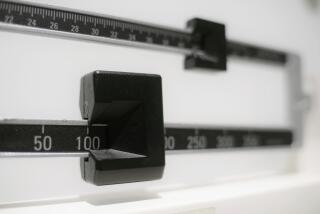PERSONAL HEALTH : Slowing Down on the Fasting
- Share via
Fasting, a habit as old as eating, is back in the news again. Before being hospitalized for chest pains last week, pop star Michael Jackson had been following his routine of periodic fasting, according to his publicist. (Doctors say there is usually no connection between fasting and Jackson’s condition, which was diagnosed as inflammation of the ribs.)
Fasting is widespread as a dieting and “cleansing” aid, said Dr. Ronald Pechan, medical director of the Center for Health Assessment at St. John’s Hospital and Health Center, Santa Monica. “Women often say, ‘I’ll just fast for a few days to fit into that dress for the party,’ ” Pechan said. Weekend overeaters sometimes fast a day in hopes of undoing the caloric damage. And some people tell Pechan they fast periodically to “cleanse the body of impurities.”
Juice fasts are another common weight-reduction ploy, said Jody Lander Spector, a registered dietitian who coordinates the weight control program at St. Vincent Medical Center. None of these fasting strategies is wise, Spector and Pechan agree. They do see a role for medically supervised fasts--but only if people have more than 30 pounds to lose. “If people are fasting for weight-reduction purposes, they should do it under a doctor’s supervision,” Pechan said.
Self-imposed, unsupervised fasting on a habitual basis can play havoc with the body, Pechan added. “Following a weekly fast, say two days a week, every week, could start to interfere with body systems.”
Fasting can cause sluggishness and fatigue and may cause muscle cramps.
“In the winter, you could feel very cold because your metabolism slows,” Pechan said. “Those who fast can also feel dehydrated and lightheaded. And fasting could lead to heart problems. Potassium levels could be altered, affecting the rhythm of the heart.”
Fasting may seem like an easy way to avoid weight gain, Spector acknowledged.
“But it’s not safe.” Instead, she tells clients: “Try to balance calories. If you overeat one day, subtract the same amount of calories the next. Or get out and exercise.”
POINT / COUNTERPOINT Making Bones About Osteoporosis
What’s the best approach to prevent or minimize osteoporosis, the bone-thinning disease that often strikes women after menopause? For years, experts have debated the safety of estrogen replacement therapy and have studied the effects of diet and exercise on bone mass. There’s no consensus about the best way to halt osteoporosis. But here are the opinions of two experts.
Diet, exercise and estrogen replacement only when necessary. Dr. Morris Notelovitz, Women’s Medical and Diagnostic Center, Gainesville, Fla.
“Women should take in 1,200 to 1,400 milligrams of calcium a day. (The Recommended Daily Allowance ranges from 800 to 1,200 milligrams.) Most women only consume about 350 milligrams. We suggest taking two 500-milligram supplements, one in the morning and one in the evening. Put the calcium tablet by your toothbrush to make it easier to remember. We also recommend muscle-strengthening exercises three times a week and aerobic exercise four to five times a week. The length of time should be individualized.
“If a (postmenopausal) woman has normal bone density and maintains it with diet and exercise alone, she should skip estrogen replacement. If the bone mass declines, she should consider estrogen replacement.”
Estrogen replacement on a short-term basis. Dr. S.B. Gusberg, emeritus professor of gynecology, Mt. Sinai School of Medicine.
“This triad of diet, exercise and estrogen replacement when necessary is sensible. But estrogen replacement therapy on a short-term basis might be an option for some women. Many experts believe that if women take estrogen supplements for just five to eight years after menopause, it can help reduce some of the bone-thinning. The supplement should include estrogen and progestin to reduce the risk of endometrial cancer.”
Back on Saddle Again With Padded Briefs
Love to cycle but loathe those skintight, unforgiving bike shorts? Padded bike briefs, newly introduced by an Idaho company, are designed to minimize chafing and “saddle sores” in the same way bike shorts do. Cyclists can wear loose shorts or even sweat pants over them, said Stephen Horowitz, president of Andiamo!, the Sun Valley-based manufacturer.
The briefs retail for about $18 in sporting goods stores and bike shops.


